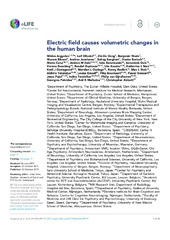Electric field causes volumetric changes in the human brain
| dc.contributor.author | Argyelan, Miklos | en_US |
| dc.contributor.author | Oltedal, Leif | en_US |
| dc.contributor.author | Deng, Zhi-De | en_US |
| dc.contributor.author | Wade, Benjamin | en_US |
| dc.contributor.author | Bikson, Marom | en_US |
| dc.contributor.author | Joanlanne, Andrea | en_US |
| dc.contributor.author | Sanghani, Sohag | en_US |
| dc.contributor.author | Bartsch, Hauke | en_US |
| dc.contributor.author | Cano, Marta | en_US |
| dc.contributor.author | Dale, Anders M. | en_US |
| dc.contributor.author | Dannlowski, Udo | en_US |
| dc.contributor.author | Dols, Annemieke | en_US |
| dc.contributor.author | Enneking, Verena | en_US |
| dc.contributor.author | Espinoza, Randall | en_US |
| dc.contributor.author | Kessler, Ute | en_US |
| dc.contributor.author | Narr, Katherine L. | en_US |
| dc.contributor.author | Ødegaard, Ketil Joachim | en_US |
| dc.contributor.author | Oudega, Mardien L. | en_US |
| dc.contributor.author | Redlich, Ronny | en_US |
| dc.contributor.author | Stek, Max L. | en_US |
| dc.contributor.author | Takamiya, Akihiro | en_US |
| dc.contributor.author | Emsell, Louise | en_US |
| dc.contributor.author | Bouckaert, Filip | en_US |
| dc.contributor.author | Sienaert, Pascal | en_US |
| dc.contributor.author | Pujol, Jesus | en_US |
| dc.contributor.author | Tendolkar, Indira | en_US |
| dc.contributor.author | van Eijndhoven, Philip | en_US |
| dc.contributor.author | Petrides, Georgios | en_US |
| dc.contributor.author | Malhotra, Anil K. | en_US |
| dc.contributor.author | Abbott, Christopher | en_US |
| dc.date.accessioned | 2020-03-20T10:04:04Z | |
| dc.date.available | 2020-03-20T10:04:04Z | |
| dc.date.issued | 2019 | |
| dc.Published | Argyelan M, Oltedal L, Deng, Wade B, Bikson, Joanlanne, Sanghani, Bartsch H, Cano M, Dale AM, Dannlowski U, Dols A, Enneking, Espinoza R, Kessler U, Narr KL, Ødegaard KJ, Oudega ML, Redlich R, Stek ML, Takamiya A, Emsell L, Bouckaert F, Sienaert P, Pujol J, Tendolkar I, van Eijndhoven P, Petrides G, Malhotra AK, Abbott C. Electric field causes volumetric changes in the human brain. eLIFE. 2019;8:e49115 | eng |
| dc.identifier.issn | 2050-084X | |
| dc.identifier.uri | https://hdl.handle.net/1956/21550 | |
| dc.description.abstract | Recent longitudinal neuroimaging studies in patients with electroconvulsive therapy (ECT) suggest local effects of electric stimulation (lateralized) occur in tandem with global seizure activity (generalized). We used electric field (EF) modeling in 151 ECT treated patients with depression to determine the regional relationships between EF, unbiased longitudinal volume change, and antidepressant response across 85 brain regions. The majority of regional volumes increased significantly, and volumetric changes correlated with regional electric field (t = 3.77, df = 83, r = 0.38, p=0.0003). After controlling for nuisance variables (age, treatment number, and study site), we identified two regions (left amygdala and left hippocampus) with a strong relationship between EF and volume change (FDR corrected p<0.01). However, neither structural volume changes nor electric field was associated with antidepressant response. In summary, we showed that high electrical fields are strongly associated with robust volume changes in a dose-dependent fashion. | en_US |
| dc.language.iso | eng | eng |
| dc.publisher | eLife Sciences Publications | eng |
| dc.rights | Attribution CC BY | eng |
| dc.rights.uri | http://creativecommons.org/licenses/by/4.0 | eng |
| dc.title | Electric field causes volumetric changes in the human brain | en_US |
| dc.type | Peer reviewed | |
| dc.type | Journal article | |
| dc.date.updated | 2020-01-22T17:23:09Z | |
| dc.description.version | publishedVersion | en_US |
| dc.rights.holder | Copyright 2019 The Author(s) | |
| dc.identifier.doi | https://doi.org/10.7554/elife.49115 | |
| dc.identifier.cristin | 1762858 | |
| dc.source.journal | eLIFE |

